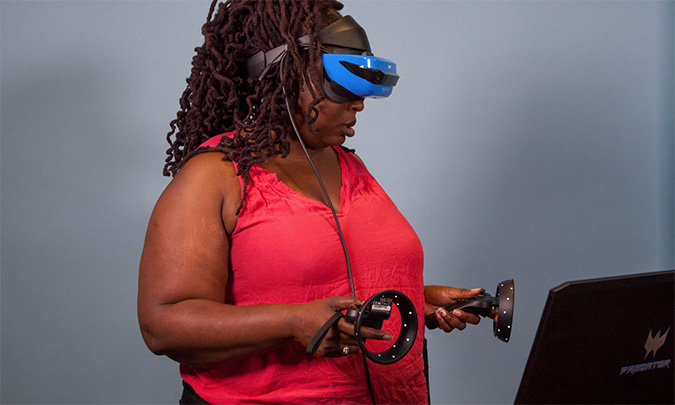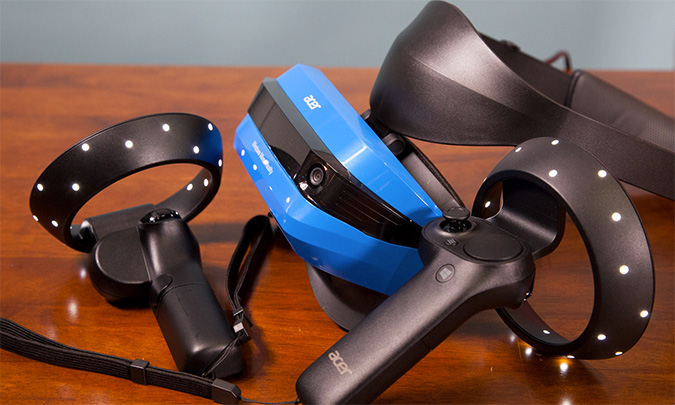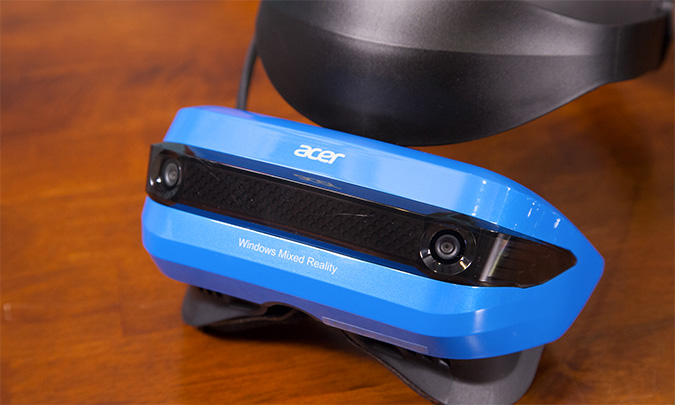Microsoft's Mixed Reality Headsets: What You Need to Know
Partnering with several popular PC makers, Microsoft has launched its new line of mixed-reality headsets. Designed to work with integrated graphics, these headsets are cheaper and more versatile than some virtual-reality headsets on the market today.
But before you go on a headset-hunting expedition, here are some key facts about the hot new tech in town so you can make an educated buying decision.
What Is Mixed Reality?
Mixed or merged reality is defined as the blending of the physical and digital worlds. In layman's terms, it's what happens when virtual and augmented reality have a baby.
Ideally, you'd put on a headset that could map your position as well as everything in the room and from that, overlay a hologram onto the physical world that would acknowledge the real-world boundaries of a coffee table or couch. A true MR headset would support both this kind of augmented reality and the closed world of virtual reality.
So Microsoft's headsets can do both AR and VR?
No, not at all. At their core, Microsoft's first-gen MR headsets only show you a virtual world, so the MR moniker is pretty much just a clever marketing ploy.
Although the headsets feature a pair of exterior sensors, they aren't being used to layer digital media into a physical space. Instead, they provide inside-out positional tracking, which keeps track of the motion controllers and your head's current position. That means these are VR headsets, albeit ones that don't need separate external sensors that the Oculus Rift or HTC Vive require.
What's the biggest difference between the MR headsets and Vive or Rift?
Glad you asked. Microsoft's MR headsets can run on integrated graphics, and don't require external sensors or a ton of setup. The MR headsets sport a refresh rate of 60Hz or 90Hz, depending on if they're connected to a PC with integrated or discrete graphics. And in most cases, Microsoft's headsets are cheaper than the Vive and the Rift and offer voice command via Cortana.
Sign up to receive The Snapshot, a free special dispatch from Laptop Mag, in your inbox.
However, the Rift and the Vive have a larger library of games between them, offer a wider field of view (110 degrees compared with 100 degrees, with the exception of the Samsung headset, which also has a 110-degree FOV) and deliver better image quality overall.
Who's making the headsets with Microsoft?
Microsoft's teaming with several heavy hitters in the PC manufacturer industry, including Acer, Dell, HP and Lenovo. Microsoft is also teaming with Samsung on the Odyssey headset, which might yield the most advanced iteration of these devices, as it will feature AMOLED lens and integrated audio by way of AKG.
What's the cheapest I can get a headset?
Microsoft's new headsets start at $299, but top out at $499. Keep in mind that the Rift and Vive cost $399 and $599, respectively.
Are they tethered?
Yes, Microsoft's headsets require a bit of plugging in, though without as many connections as the Vive or Rift. Each of the Microsoft headsets only need a USB 3.0 and a HDMI port to work. And if you're not using the Samsung headset, you'll need to plug in a pair of headphones.
What are the minimum specs?
To use one of Microsoft's MR headsets, you need the minimum specs: Windows 10 Fall Creators Update, at least 16GB of RAM, an Nvidia GTX Geforce 965M or AMD Radeon RX 460 GPU, an HDMI 2.0 or a DisplayPort 1.2, and a USB 3.0 port. Desktop owners will need to have at least a 6th-Generation Intel Core i5 processor, while the minimum entry for laptop owners is a 7th-Gen Intel Core i5 processor. The AH101 will run on systems with integrated graphics and an HDMI 1.4 port.
For an Oculus Rift, you'll need at least Windows 7, an Intel i3-6100 or AMD Radeon R9 290 (desktop) or a 6th-Gen Intel Core i7 processor (laptop), 8GB of RAM, an Nvidia GeForce GTX 1050Ti or a AMD Radeon RX 480 GPU with a USB 3.0 port, two USB 2.0 ports and an HDMI 1.3 out.
The Vive requires, at minimum, Windows 7 with an Intel Core i5-4590 or AMD Radeon FX 8350 CPU (desktop) or an 6th-Gen Intel Core i7 processor (laptop), 4GB of RAM, an Nvidia GeForce GTX 980M or a AMD Radeon RX 480 GPU with a USB 2.0 port and an HDMI 1.4 out.
Why is a 90Hz refresh rate better than a 60Hz?
There's a distinct difference between playing with a 90Hz and a 60Hz refresh rate. On premium headsets like the Vive and Rift, a 90Hz refresh rate is the gold standard. You can definitely run VR apps at 60Hz, but it's not as smooth. When I played Superhot VR and Space Pirate Trainer on the Acer Windows Mixed Reality AH101 headset, I found I had better visual quality at 90Hz, while the 60Hz experience delivered some noticeable stuttering and noticeably muddier images.
Should I use the headsets with integrated graphics?
You can in a pinch, but you're not going to get the best experience. I like the idea of more people getting the opportunity to experience virtual reality, especially at less expensive prices. However, I'd prefer that if people use these headsets they spring for a laptop with discrete graphics
How many games or apps are in the library?
Currently, the Mixed Reality section of the Windows Store is looking mighty sparse with 49 games and apps. However, later on this year, Microsoft will enable the headsets to work with content in the SteamVR store, which will put it on a par with the Vive, but not the Rift and its ever-growing library of over 2,000 games and apps.
Who would you recommend this headset to?
Microsoft's headsets are a good solution to consumers who want something better than the mobile VR experience they’d get from a Gear VR or Daydream View headset, but don't want to spend an arm, a leg or a first-born on top-of-the-line hardware. And while I'm not necessarily a fan of the 60Hz experience, I appreciate the wide gamut of notebooks these headsets can support by virtue of their integrated graphics support.
Ultimately, Microsoft has a lot of catching up to do with its new headsets. Supporting content from the SteamVR store will go a long way toward putting the MR devices on a par with the more premium headsets. For now, Microsoft’s headsets represent a positive step toward making virtual reality affordable and easy to use.

Sherri L. Smith has been cranking out product reviews for Laptopmag.com since 2011. In that time, she's reviewed more than her share of laptops, tablets, smartphones and everything in between. The resident gamer and audio junkie, Sherri was previously a managing editor for Black Web 2.0 and contributed to BET.Com and Popgadget.



